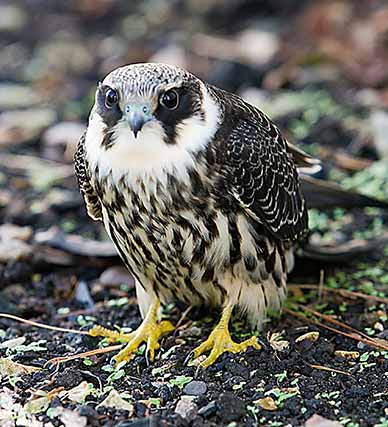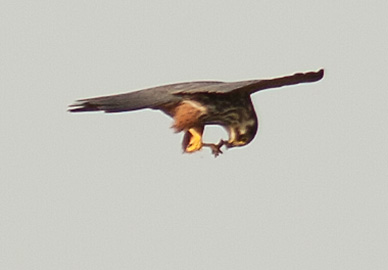Hobby (Falco subbuteo)
When: April to Sept. or early October
How many: Relatively small numbers - an estimated 20-30 pairs breeding (estimated)

(image courtesy of Richard Lock Photography)
The hobby is one of the New Forest’s very special birds. Whilst not exactly rare elsewhere in southern England, hobbies are not, however, always easy to find and watch. Yet in the New Forest, from mid-April until the end of September or early October, hobbies can regularly be seen over heaths and bogs, hawking for insects– dragonflies are favourites – that are often taken and devoured on the wing.
Indeed, soon after their arrival from African wintering grounds, hobbies sometimes gather in relatively large, well-spread numbers to hunt over the same general area in loose aggregations of up to 20 birds, all attracted by the availability of aerial foodstuffs.
The hobby is of similar size to a kestrel, although the hobby rarely hovers in the way of the more common falcon. An elegant, often dashing creature, in plunging flight the hobby’s scythe-like wings and anchor-shaped outline recall that of a swift or peregrine, although the former is smaller and slighter, and the latter larger and bulkier.
The hobby’s slender body, shortish tail, and quite long, slim, sharply pointed wings are distinctive, whilst the upperparts are very dark, slate-grey in colour. Good views reveal strongly marked vertical breast streaking, rusty-red thighs and undertail, and the falcon family’s typically dark moustachial stripe.
Hunting flight, too, is distinctive. When hawking insects, hobbies often quarter an area of land in quite high, loose-winged flight, intermittently accelerating then losing speed, looking out for passing prey that is often caught after a series of rapid, acrobatic twists and turns. Clutching its catch, the hobby stretches down its razor sharp bill to take the meal.
Woodland passerines and other small birds, including fast-flying swallows, martins and swifts, are regular prey items, particularly when there are hungry young hobbies to feed. Chased down in flight or caught at the end of a high speed stoop, birds are taken to a perch to be plucked and eaten; or are delivered straight to the nest.
(The word hobby comes from the bird’s French name hobereau, which derives from hober, meaning ‘to stir’, a reference to the effect that the appearance of a hobby has on flocks of small birds).
Hobbies continue to arrive until early June. Overlapping home ranges can extend up to 6.5 kilometres (4 miles) from the nest, and are occupied almost immediately the birds arrive. Disused carrion crow’s nests, particularly those built in the previous or current spring, quite high in a Scot’s pine are often taken over by a hobby. Woodland edge trees are favoured and so are single trees or those in isolated clumps. The hobby does not add material, although some of the lining may be removed.
Hobbies are quite late breeders – eggs are laid from late-May until early-July - largely, it is thought, to ensure that late-summer insect peaks and the availability of newly fledged young birds coincides with the period when large quantities of food are required to feed the growing hobby brood.
Two to three eggs are usual, incubation and fledging take on average around 30 days each, and newly fledged youngsters are seen well into September, and occasionally later. Hunting is primarily by the male throughout the nesting period - the female incubates the eggs, broods the young, and stands guard as they get older, even for a while after they leave the nest.

Return migration is apparent from late-August, and peaks in September as the birds steadily make their way south. But sadly, not all make it at the first attempt. The young hobby shown above was discovered in early autumn 2006, in the grounds of Oakhaven Hospice, near Lymington. A badly damaged wing prevented onward flight so it was taken in by the Weyhill-based Hawk Conservancy Trust for repair, rest, recuperation and release the following spring to join other new arrivals on the breeding grounds. There’s no way of knowing, though, whether this hobby originated in the New Forest, or how the wing was damaged.
In the Birds of Hampshire, published in 1993, a New Forest breeding population of around 20 pairs of hobbies was suggested, but non-breeders are, of course, also present - few hobbies breed until they are two years old, although some apparently attach themselves to established pairs and help rear their youngsters! In 2006, sightings noted in the Hampshire Bird Report suggested the existence of up to 30 territories.
Nationally, the hobby is doing rather well, and in recent years has spread northwards and westwards within the British Isles, presumably occurring now in places that previously did not support sufficient insect prey.
References:
Collins Bird Guide: Killian Mullarney, Lars Svensson, Dan Zetterstrom and Peter J.Grant
The Birds of the Western Palearctic, Concise Edition: D.W. Snow and C.M. Perrins
The New Forest – A Natural History: Colin R. Tubbs
Birds of Hampshire: Hampshire Ornithological Society
Hampshire Bird Reports: Hampshire Ornithological Society
Raptors – A field guide to survey and monitoring: John Hardey, Humphrey Crick, Chris Wernham, Helen Riley, Brian Etheridge, Des Thompson
All the Birds of the Air: Francesca Greenoak
More links
Other related links
Search this site

Sadly, 58 animals were killed - 35 ponies, 13 cows, 8 donkeys and 2 sheep, whilst a further 32 were injured - 3 pigs, 9 donkeys, 11 cows and 9 ponies.
(Forty-three accidents occurred in daylight, 15 at twilight and 101 in the dark. Twenty-seven accidents were not reported by the driver involved).
Here's just one horrific example - Three donkeys killed in collision with van at notorious New Forest blackspot (Advertiser and Times)

